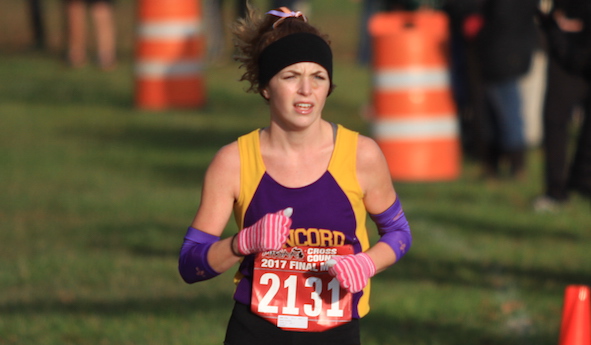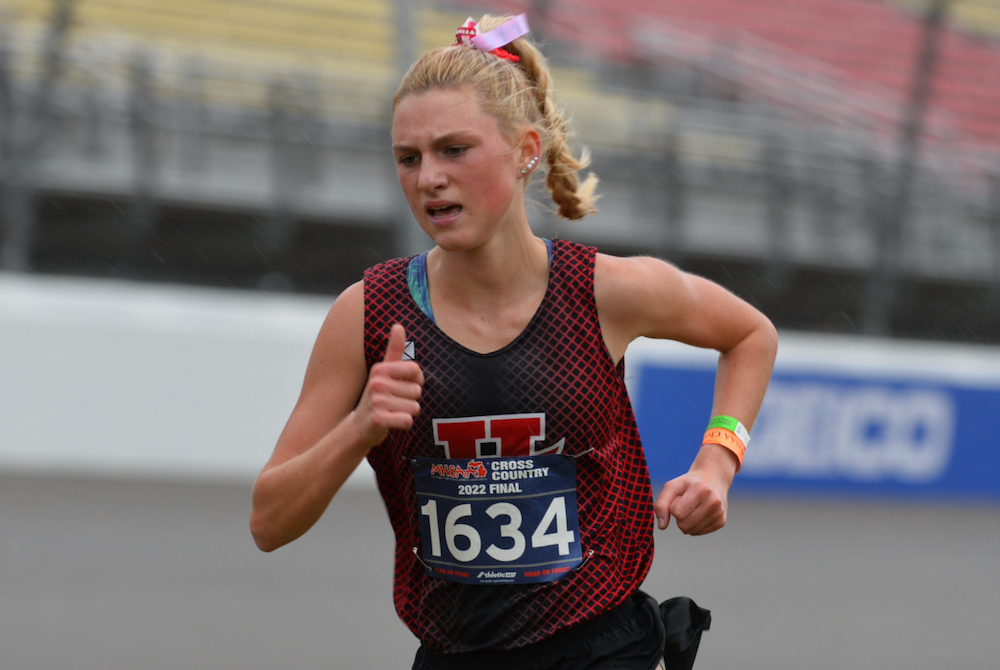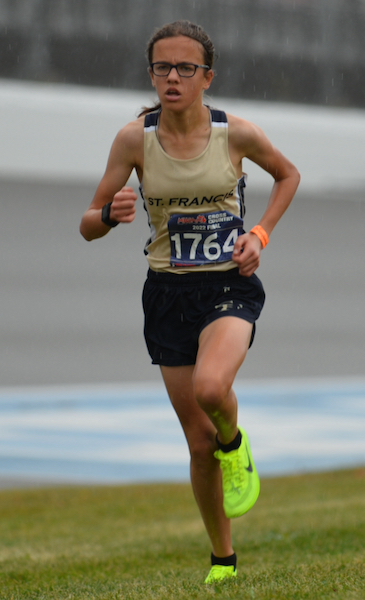
Concord Senior Rises, Irish Stay on Top
November 4, 2017
Second Half reports
BROOKLYN — When Samantha Saenz of Concord needs training partners or racing advice, she leans upon the school’s boys team.
“I don’t have many girls on my team, so I train with the boys, so that helps,” she said. “They’re fast.”
So is Saenz.
Moving through the pack for four years, she found herself alone in front throughout the entire race Saturday on her way to the MHSAA Lower Peninsula Division 4 individual championship at Michigan International Speedway.
She became Concord’s first female Finals champion since Jenny Franssen won Class D in 1982.
The school has produced nine boys individual titles won by six runners. Saenz knows two of them, 2009 champion Kyle Stacks and three-time winner Jesse Hersha, who was a senior in 2014 when Saenz was a freshman.
“Jesse Hersha gives really good advice,” Saenz said. “I learned that pain is temporary and pride is forever. Kyle Stacks also helps with our team.”
Saenz ran a solo race up front, posting a time of 18:16.8. She has been all-state all four years, improving from 22nd as a freshman to seventh as a sophomore to third as a junior.
“It feels so good,” she said. “I’ve been working for it for four years. I finally got it. I’m so happy.”
Finishing second for the second year in a row was Mount Pleasant Sacred Heart senior Bailley McConnell, who finished in 18:44.1. Teammate Scout Nelson was third in 18:46.6.
 McConnell and Nelson led Sacred Heart to its third straight team championship with a score of 39 points. Ubly was second with 138 and Lansing Christian took third with 141.
McConnell and Nelson led Sacred Heart to its third straight team championship with a score of 39 points. Ubly was second with 138 and Lansing Christian took third with 141.
There were four McConnell sisters on last year’s championship team. Alexis McConnell graduated and junior Cammie McConnell was injured Saturday, so it was just Bailley and sophomore Desiree McConnell representing the family this year at MIS.
“It’s pretty sweet,” Bailley said. “This year it was a little different, because last year I had my two sisters actually run with me the whole time for most of it, whereas this year I ran with different teammates because I wasn’t able to run with my younger sister as much.”
Completing the scoring for Sacred Heart were Desiree McConnell (eighth, 19:21.0), Lauren MacDonald (19th, 19:56.3) and Rowan Fitzpatrick (23rd, 20:01.8).
The Irish’s score was the 10th-lowest by a girls team champion in any division or classification since the MHSAA began sponsoring a girls meet in 1978. Last year’s Sacred Heart team set a Division 4 record that ranks sixth all-time with a score of 34 points.
“It’s really nice,” Bailley McConnell said. “Working together, we’re able to stay pretty consistent, and we try to work with each other to know what we’re supposed to do.”
Junior Haili Gusa led Ubly to its runner-up finish, placing seventh in 19:15.6. It was Ubly’s best team finish, surpassing a fifth-place showing in 2004.
PHOTOS: (Top) Concord’s Samantha Saenz pulls away from the field in winning Saturday’s Division 4 race. (Middle) Sacred Heart’s Scout Nelson, left, and Bailley McConnell led the Irish to a third straight team championship. (Click for more from RunMichigan.com.)

Jazwinski Brings Hart Individual Title as St. Francis Moves to Front of Team Pack
November 5, 2022
BROOKLYN – Cross country races can be won between the ears before runners ever step foot onto the course.
Attitudes were tested as rain began to descend on Michigan International Speedway and the wind picked up just before the start of the MHSAA Lower Peninsula Division 3 girls race late Saturday morning.
Hart sophomore Jessica Jazwinski was loving life as she prepared to race.
“As a distance runner, I really try to love the wind,” she said. “Distance running and cross country is just a tough sport. The wind just adds to it — and the rain, too. It’s super fun.
“I was just thinking these conditions are just gonna feed my great race. This is real cross country. Yeah!”
Jazwinski overcame the elements to run the fifth-fastest Division 3 time ever, winning with a time of 17:36.70. She has two of the top-five times in Division 3 Finals history, having run 17:31.4 to place third last year.
“Today my race plan was just to go out hard and try to hold on to my pace,” she said. “I feel like I tried to race a lot like Steve Prefontaine, just go out and hold on.”
 Lansing Catholic senior Hannah Pricco was second in 18:17.59, Onsted sophomore Emmry Ross was third in 18:20.96 and Hart junior Alyson Ens was fourth in 18:28.52.
Lansing Catholic senior Hannah Pricco was second in 18:17.59, Onsted sophomore Emmry Ross was third in 18:20.96 and Hart junior Alyson Ens was fourth in 18:28.52.
“I love having great teammates to work with and encourage each other,” Jazwinski said. “We really try to encourage each other so much throughout the races. Throughout this year, some races she’s been a minute behind me, some races she’s been five seconds. I don’t want her to ever beat me, so that pushes me so much. I know she’s trying to race me and get up there with me.”
The only downer for Hart was having its string of Division 3 championships end at five with a fourth-place finish. Hart had two runners in the top four, but its No. 3 runner was 68th.
“I would totally trade my individual title for a team title,” Jazwinski said.
Traverse City St. Francis emerged from a close battle to win its first title since 2016 with 134 points. Pewamo-Westphalia was second with 142 and Lansing Catholic third with 165.
Sophomore Betsy Skendzel led St. Francis, placing seventh in 18:48.33. Completing the team score were senior Sophia Rhein in 26th (19:43.27), sophomore Grace Slocum in 33rd (20:07.95), junior Rylee Duffing in 60th (20:44.82) and junior Margot Hagerty in 63rd (20:45.78).
Lansing Catholic had three place in the top 10, but didn’t get another finisher until 103rd.
PHOTOS (Top) Hart’s Jessica Jazwinski pushes toward the finish during Saturday’s LPD3 Final. (Middle) Traverse City St. Francis’ Betsy Skendzel leads the way for the eventual team champion. (Click for more from Dave McCauley/RunMichigan.com.)

